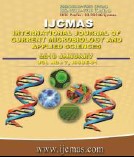


 National Academy of Agricultural Sciences (NAAS)
National Academy of Agricultural Sciences (NAAS)

|
PRINT ISSN : 2319-7692
Online ISSN : 2319-7706 Issues : 12 per year Publisher : Excellent Publishers Email : editorijcmas@gmail.com / submit@ijcmas.com Editor-in-chief: Dr.M.Prakash Index Copernicus ICV 2018: 95.39 NAAS RATING 2020: 5.38 |
To study the effect of eleven strains of rhizobacteria, namely Azotobacter chroococcum (103, MSX-9, HT-54 and BNR-6), Gluconacetobacter diazotrophicus (CO 99-70, 35-47 and 760-50), Bacillus spp (91 and 65), Pseudomonas fluorescens and Pseudomonas maltophila were used on rice (cv. PR-106) infected with Meloidogyne graminicola under greenhouse conditions. Soaking of seed for five minutes in plain water was treated as untreated check. After 45 days of sowing results indicated that all the rhizobacterial strains significantly increased the plant height and weight and reduced the number of galls/plant and multiplication of M. graminicola on rice significantly over untreated check, except A. chroococcum strain 103. Maximum plant height (6.75cm) was recorded in G. diazotrophicus strain 760-50 and B. spp. 91. Similarly, maximum plant weight 0.83g and 0.93g recorded in both treatments, respectively. However, maximum reduction of nematode population (0.5 and 0.6) times was observed in G. diazotrophicus strain 760-50 and A. chroococcum strain BNR-6, respectively over untreated check (1.5).
 |
 |
 |
 |
 |